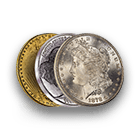As a fledgling colony, Australia faced a major problem: lack of money, specifically coinage for use in commerce. The colonial population of Australia would use any foreign coin or even barter for their transactional needs. Attempts to control commerce by the colonial government failed in both the valuation of foreign species and in attempts to prohibit barter of rum. It wouldn’t be until 1812 when the government of New South Wales, Governor Lachlan Macquarie, was sent 40,000 Spanish 8 reales on the HMS Samarang from the East India Company. These coins were used to fill the need for New South Wales, Australia.
New South Wales faced a problem that many other colonies faced – keeping the coinage domestic and preventing its export. Much like areas in the Caribbean, Australia chose to cut and countermark these Spanish “Dollars” to keep them in New South Wales. A convicted forger named William Henshall was given the task of cutting and countermarking the 40,000 coins. The center was cut out of each coin, and the resulting inner hole of the dollar was counterstamped “New South Wales 1813” on the obverse and “Five Shillings” on the reverse. The center cut of the coin, also known as the dump, was also stamped over with dies featuring a crown and “New South Wales 1813” on the obverse and “Fifteen Pence” on the reverse. The valuation of these coins combined was six shillings, three pence, which was a full 25% higher than the actual value of the intact Spanish 8 reales. This kept the coins in New South Wales by removing the incentive of exporting.
It took over a year for the coins to be converted, and the total mintage was 39,910 holey dollars and dumps. By decree of July 1, 1813, the coins became legal tender in New South Wales, becoming Australia’s first struck coins. The coins were successful in elevating the needs of the colony. By 1822, the import of British coins had become more frequent, and the holey dollars and dumps started to be removed from circulation by the government. In 1829, the coins would be officially demonetized. It is believed that the majority of the coins were successfully removed and melted down.
Today, an estimated 350 holey dollars and 1,500 dumps are believed to still exist. At the beginning of 2025, one of these surviving pieces was submitted to the PCGS office in Hong Kong. Because the origin of the Spanish 8 reales came from Madras, India, all the coins were mixed from different mints and years, making each surviving piece scarcer when taking the host into account. This example used the host of a Mexico City Mint Charles IV issue dated 1789. In previous auction records, only two other examples from this host have been noted since 2011. This coin was evaluated by PCGS and graded VG08, with the countermarked portion being of VF Details. Rare and desirable in any condition, this outstanding survivor was a highlight of this Hong Kong Express submission and is now protected for the future by PCGS.








 Copper & Nickel
Copper & Nickel
 Silver Coins
Silver Coins
 Gold Coins
Gold Coins
 Commemoratives
Commemoratives
 Others
Others
 Bullion
Bullion
 World
World
 Coin Market
Coin Market
 Auctions
Auctions
 Coin Collecting
Coin Collecting
 PCGS News
PCGS News